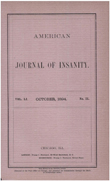Superior temporal gyrus volume in schizophrenia: a study using MRI morphometry assisted by surface rendering
Abstract
OBJECTIVE: Interpretation of the literature concerning superior temporal gyrus volume in patients with schizophrenia is complicated by methodological variation between studies and by the difficulty of identifying gyral boundaries in serial sections. METHOD: With the aid of three-dimensional cortical renderings, the authors developed a morphometric approach in which information from the cortical surface is incorporated into gyral boundary decisions. Using this technique, they assessed superior temporal gyrus volume in young, right-handed male patients with schizophrenia and in right-handed male comparison subjects. They also compared their technique with existing slice-based morphometric methods by using previously reported subcortical landmarks to define the gyral boundaries. RESULTS: There was no significant main effect of diagnosis and no significant diagnosis-by-hemisphere interaction. Significant leftward laterality was present only among comparison subjects. Leftward superior temporal gyrus laterality did not correlate with leftward laterality of the planum temporale. No significant reduction in superior temporal gyrus volume was revealed in the patients. No significant leftward laterality was detected with the slice-based technique, suggesting that a significant portion of superior temporal gyrus tissue is omitted with this approach. The lack of findings could not be explained by a general absence of morphometric abnormalities in this group of subjects because the patients had significantly larger lateral ventricles. CONCLUSIONS: Significant reduction in the superior temporal gyrus volume was not confirmed in this group of patients with schizophrenia, probably because of the small effect size of this finding. Methodological variation is an important factor in determining superior temporal gyrus volume on magnetic resonance imaging scans.
Access content
To read the fulltext, please use one of the options below to sign in or purchase access.- Personal login
- Institutional Login
- Sign in via OpenAthens
- Register for access
-
Please login/register if you wish to pair your device and check access availability.
Not a subscriber?
PsychiatryOnline subscription options offer access to the DSM-5 library, books, journals, CME, and patient resources. This all-in-one virtual library provides psychiatrists and mental health professionals with key resources for diagnosis, treatment, research, and professional development.
Need more help? PsychiatryOnline Customer Service may be reached by emailing [email protected] or by calling 800-368-5777 (in the U.S.) or 703-907-7322 (outside the U.S.).



